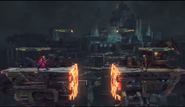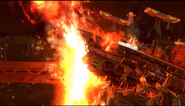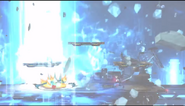Midgar is a new downloadable stage in Super Smash Bros. for Nintendo 3DS and Wii U that is packaged with Cloud. The release date and price are unknown.
Stage Overview
The stage heavily resembles Battlefield in design, with a main platform and three platforms above it. During gameplay, a Summon Materia may show up, and anyone who gets will be able to call recurring Summon Creatures from the Final Fantasy series, in their Final Fantasy VII incarnations to unleash their signature attacks, some of which disrupt and affect the positioning of the stage itself. These include:
- Odin, who will attack with Zantetsuken, which can instantly kill a character and will literally slice the stage in half, with the two halves separating from each other similarly to Brinstar.
- Leviathan, who will attack with Tidal Wave, which will cause a massive flood and allow players to swim besides the limits of the stage.
- Ramuh, who will attack with Judgement Bolt, which will electrify parts of the stage, causing damage and knocking back characters who stand on it.
- Ifrit, who will attack with Hellfire, erupting a pillar of flames on one of the edges of the stage, throwing it off balance.
- Bahamut ZERO, who will attack with Tera Flare, attack from the skies with a massive laser that will randomly strike a part of the stage, causing huge damage and knockback.
Origin
Midgar is the capital city and power base of the Shinra Electric Power Company in the world of Final Fantasy VII. Midgar was the most technologically advanced location ever constructed on the planet of Gaia. It consists of a large circular structure supported above the ground by eight reactors and a central pillar, with various other supports around the city.
On top of the structure lies the city proper, divided into eight sectors, while underneath it on the ground lies a large slum; created by the city's unfortunate and downtrodden. It is mentioned Midgar was once eight individual towns, but as Midgar came into existence their names were forgotten in favor of referring to the different areas as sectors.
| ||||||||||||||
| ||||||||||||||





